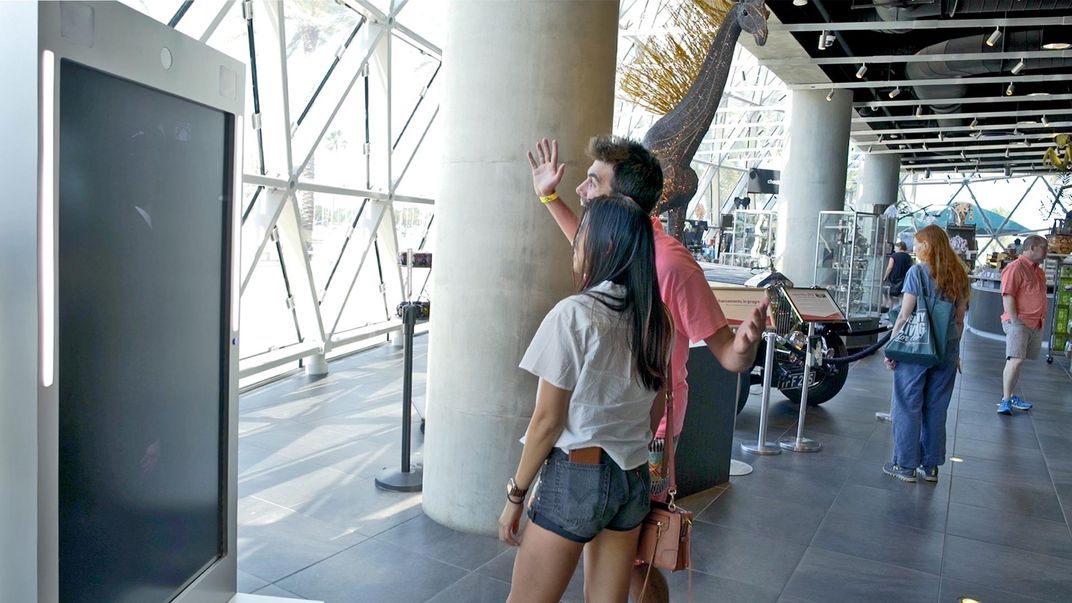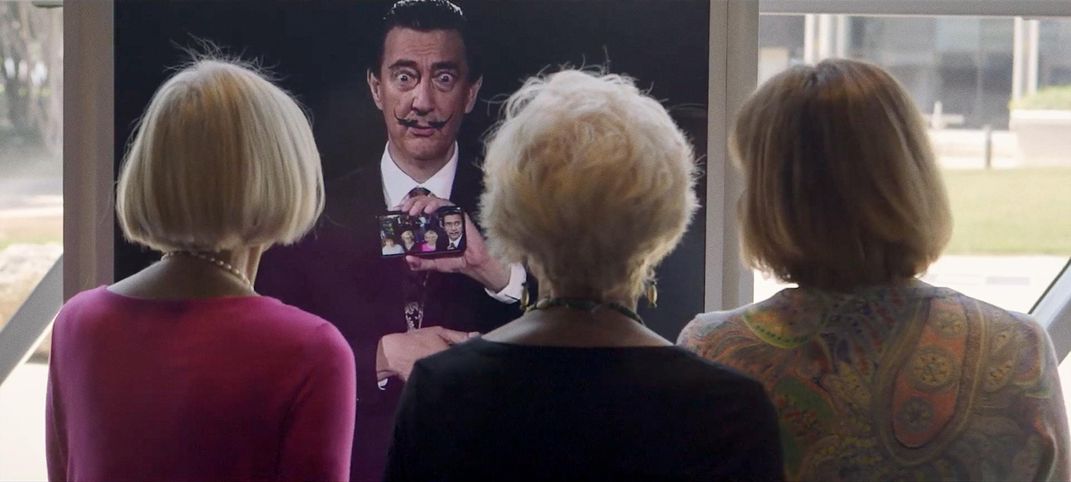With a Little Help From A.I., the Dali Museum Brings the Famed Surrealist to Life
Visitors to the museum in St. Petersburg, Florida can meet Salvador Dalí “in person”
/https://tf-cmsv2-smithsonianmag-media.s3.amazonaws.com/filer/60/8e/608e91c1-652f-4846-839d-0e2f96e8c7e5/dali_lives_-_onsite_1.jpg)
Salvador Dalí wasn't exactly modest. And he’ll tell you so, too, face to face at the Dali Museum in St. Petersburg, Florida. Here, the Spanish surrealist is alive and well, ready to talk to you in person about his art and his processes.
Well, sort of. This Dalí is a reanimated version, brought to life through the magic of artificial intelligence. It’s a newly opened exhibition called "Dali Lives," and it stretches across the entire Dali Museum, which boasts more than 2,000 Dalí works in about 20,000 square feet of exhibit space. Three interactive video panels showing a life-size Dalí, standing 5'8" tall, comprise the exhibit—one at the museum entrance, one on the third floor by the main displays (including Dalí's paintings and sketches, photographs, sculptural objects, two tech-enhanced paintings allowing visitors to put themselves inside the image, and a virtual reality experience of walking through Dalí's 1934 painting "Archeological Reminiscence of Millet's Angelus"), and one in the gift shop on the way out. Each one offers a different experience when you push a doorbell on the panel to get Dalí’s attention.
Salvador Dalí was born in Figueras, Spain, 115 years ago, on May 11, 1904. His parents named him after his brother who died nine months before he was born. He spent much of his childhood on the nearby Pinchot estate, learning about art, and began classes at the local drawing school in 1916. By the mid-1920s, Dalí devoted his life to painting in earnest. Surrealism began to play a heavy role in his work, as he sought to shed the shackles of conventional art, and he settled into his own style in the early '30s. Throughout his life, he created art pieces; worked on scripts with celebrities like Walt Disney, Alfred Hitchcock and the Marx Brothers; designed jewelry; and wrote for newspapers and magazines. Dalí was the first artist to create a video of himself talking and painting (an exercise Bob Ross and others would later take up), and one of the first artists to use holograms in his work—creating a portrait of shock-rocker Alice Cooper in 1973. He died on January 23, 1989.
“Dalí himself was at the forefront of technology and was always experimenting and trying new things,” says Beth Bell, marketing director at the Dali Museum. “We feel obligated to keep that legacy going. We think he would love these types of things. It’s in the spirit of Dalí himself.”

The museum first opened in 1982, when A. Reynolds and Eleanor Morse—friends of Salvador and Gala Dalí—decided to donate their extensive Dalí collection. St. Petersburg received it because the city, as opposed to other museums and universities, was willing to keep the entire collection intact—a stipulation of the donors. The museum moved into a new building in 2011, one Dalí would likely be proud of: it's a huge concrete block with a 75-foot-tall bubble made up of 1,062 triangular pieces of glass bulging out of its side. Outside, a garden infuses math and nature—Dalí appreciated the neatness of mathematics. Inside, there's a helical staircase, paying homage to Dalí's obsession with spirals.
In the first of the "Dali Lives" screens, at the front of the museum, Dali comes to welcome you: “This morning you hear the true story of Dali and his art, and you see the greatest paintings you have ever seen,” he says after he sashays to the screen from where he was pacing in the background. “Modesty is not my specialty.” This first interaction with Dali changes based on the day and the weather, prompting different lines of conversation between the visitor and the artist.
For the second panel, on the third floor, Dalí is painting in the background. Ring the doorbell and he’ll get up and come talk about his work. This is the meat of the exhibit. There’s about 45 minutes of new Dalí footage contained in this panel, with different segments prompted by the doorbell ring. He’ll talk about his paintings, his wife Gala, his brother who died before he was born (“I wish to prove to myself I am not le dead brother, but le living one”), and his personality, noting, “The only difference between a madman and myself is that I am not mad.” After chatting with Dalí, visitors can find the paintings he speaks about on display, seeing them from a more informed viewpoint.
In the third panel interaction in the gift shop, Dalí bids you farewell—but not without taking a photo first. He thanks you for visiting, invites you back, and calls you closer to take a selfie together on his virtual cell phone. Then he’ll ooh and aah over the photo, and text it to you. At the end of the interaction, he gives a signature goodbye, saying, “Kiss you, bye-bye!”

The most stunning thing about "Dali Lives" is that you’re interacting with a version of the artist himself. It looks like Dalí, it sounds like Dalí, it is Dalí. The museum worked together with the San Francisco advertising agency Goodby Silverstein & Partners to accomplish this, feeding hundreds of news interviews (both written and video), quotes from his autobiography and other written works, and archival video footage into an artificial intelligence system to recreate the artist. That 45 minutes of new footage—with 190,512 possible video combinations—is created from more than 6,000 frames of existing Dalí video and more than 1,000 hours of A.I. learning.
Once all the material was gathered and the A.I. system learned the intricacies of Dalí’s movements and expressions, the museum and GS&P worked together with an actor with the same body type as Dalí and a voice actor. The voice actor recorded all the scripts, which were then sent to the body actor, who acted along with the scripts—then the video footage was sent back to the voice actor to re-record any words that didn’t look perfect, and the A.I. superimposed Dalí’s face over the body actor’s face. The scripts and physical movements were very specific to what the A.I. system understood.
“The learning process to get it right was interesting,” says Severin Sauliere, interactive producer at GS&P. “We had to tell the actor what kind of movements to make. If he moved in the wrong way, the A.I. wouldn’t know how to interpret it.”
The result was a living, moving version of Dalí ready to converse with anyone who wants to talk. He can't hear you to respond to your questions directly, but the scripts are extensive and cover most questions that would naturally flow so it gives the illusion of real-time interaction. In total, it took about a year to take the exhibit from conception to implementation—and early tests of the technology show that the wait was worth it.
“Some people have cried,” says Hank Hine, executive director at the Dali Museum. “Just the fact that someone has been resurrected, it’s pretty amazing. It has this spiritual impact. If you can see Dalí come alive, then why not believe in resurrection, eternity and your own immortality—and the immortality of those you love. It’s very uplifting.”
"Dali Lives" is on display at the Dali Museum through June 15, 2022.
Planning Your Next Trip?
Explore great travel deals
Smithsonian magazine participates in affiliate link advertising programs. If you purchase an item through these links, we receive a commission.
/https://tf-cmsv2-smithsonianmag-media.s3.amazonaws.com/accounts/headshot/JenniferBillock.png)


/https://tf-cmsv2-smithsonianmag-media.s3.amazonaws.com/accounts/headshot/JenniferBillock.png)